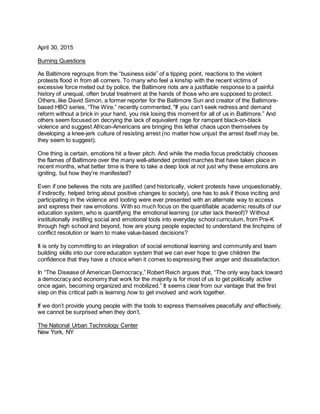
Burning questions editorial
- 1. April 30, 2015 Burning Questions As Baltimore regroups from the “business side” of a tipping point, reactions to the violent protests flood in from all corners. To many who feel a kinship with the recent victims of excessive force meted out by police, the Baltimore riots are a justifiable response to a painful history of unequal, often brutal treatment at the hands of those who are supposed to protect. Others, like David Simon, a former reporter for the Baltimore Sun and creator of the Baltimore- based HBO series, “The Wire,” recently commented, "If you can’t seek redress and demand reform without a brick in your hand, you risk losing this moment for all of us in Baltimore.” And others seem focused on decrying the lack of equivalent rage for rampant black-on-black violence and suggest African-Americans are bringing this lethal chaos upon themselves by developing a knee-jerk culture of resisting arrest (no matter how unjust the arrest itself may be, they seem to suggest). One thing is certain, emotions hit a fever pitch. And while the media focus predictably chooses the flames of Baltimore over the many well-attended protest marches that have taken place in recent months, what better time is there to take a deep look at not just why these emotions are igniting, but how they’re manifested? Even if one believes the riots are justified (and historically, violent protests have unquestionably, if indirectly, helped bring about positive changes to society), one has to ask if those inciting and participating in the violence and looting were ever presented with an alternate way to access and express their raw emotions. With so much focus on the quantifiable academic results of our education system, who is quantifying the emotional learning (or utter lack thereof)? Without institutionally instilling social and emotional tools into everyday school curriculum, from Pre-K through high school and beyond, how are young people expected to understand the linchpins of conflict resolution or learn to make value-based decisions? It is only by committing to an integration of social emotional learning and community and team building skills into our core education system that we can ever hope to give children the confidence that they have a choice when it comes to expressing their anger and dissatisfaction. In “The Disease of American Democracy,” Robert Reich argues that, “The only way back toward a democracy and economy that work for the majority is for most of us to get politically active once again, becoming organized and mobilized.” It seems clear from our vantage that the first step on this critical path is learning how to get involved and work together. If we don’t provide young people with the tools to express themselves peacefully and effectively, we cannot be surprised when they don’t. The National Urban Technology Center New York, NY